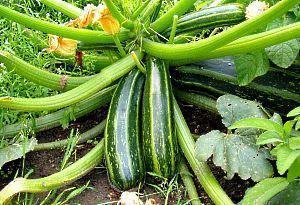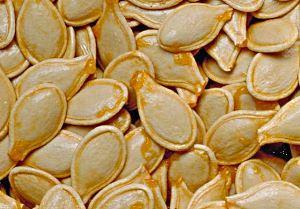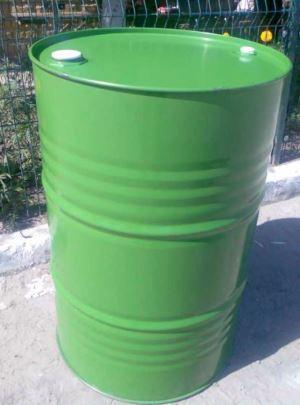Secrets of growing zucchini: advice from experienced summer residents
 Zucchini recently began to enjoy more and more love among gardeners. Why? Yes, because this vegetable is just a storehouse of vitamins and trace elements, and it is also great for the first feeding of babies, which only adds to its popularity.
Zucchini recently began to enjoy more and more love among gardeners. Why? Yes, because this vegetable is just a storehouse of vitamins and trace elements, and it is also great for the first feeding of babies, which only adds to its popularity.
So what is the right way to grow zucchini? Let's figure it out!
Starting small - seeds and seedlings
There is a clever way to grow zucchini. To do this, it is necessary to warm up the seeds before germination. So the seedlings will go more amicably, and the productivity of plants will increase significantly. It is quite suitable to spend the night with a bag of seeds on the switched on heating battery.

At room temperature, after three to five days, they reach several centimeters in length. It is at this stage that zucchini is planted in open ground. Do not over tighten with this, otherwise the long roots will quickly intertwine, and it will be difficult to separate one seed from another without damage.
Growing zucchini in a barrel is common
The size of your land plot does not allow you to allocate a vast area for courgette beds? No problem. In such cases, among fans of pumpkin plants, one of the most popular ways of growing squash has become the construction of "green barrels".
Cooking a barrel
 A barrel for growing zucchini must have a capacity of at least two hundred liters, and in its middle, be sure to stretch a pipe pierced in several places. It will be used for watering zucchini. Several holes must be made in the bottom of the barrel to drain excess moisture.
A barrel for growing zucchini must have a capacity of at least two hundred liters, and in its middle, be sure to stretch a pipe pierced in several places. It will be used for watering zucchini. Several holes must be made in the bottom of the barrel to drain excess moisture.
When installing the barrel, pay particular attention to the average summer temperatures in your area. Is it over thirty degrees (Celsius)? Then place the barrel on the north side of the site, where it will be cooler. If clouds are not uncommon in your area, place it in the south.
Now you can start filling the zucchini barrel with substrate for your future crop.
It is filled with layers, each of which is a delicacy for zucchini:
- At the bottom, a twenty to thirty centimeter layer of brushwood is laid, which will serve as drainage.
- Five to six centimeters of compost and the same number of last year's rotted leaves. Above - a couple of centimeters of ordinary garden soil.
- Five centimeters of hay and tops of any crop (ideally potatoes). Again a few centimeters of garden soil.
- Finally, three to four centimeters of medium fraction sawdust and peat... We finish filling the barrel with another layer of garden soil.
A couple of days before planting seeds or seedlings into the barrel, the mixture must be highly moistened. This will require about ten liters of water.
Planting and leaving
 For growing zucchini in a barrel, the following are best suited varieties, like Long-fruited, Apollo F1, Gribovsky 37, Beloplodny, Sosnovsky, Pharaoh. Planting seedlings into the ground is carried out when the mixture in the barrel warms up enough. This usually happens in the second half of May.
For growing zucchini in a barrel, the following are best suited varieties, like Long-fruited, Apollo F1, Gribovsky 37, Beloplodny, Sosnovsky, Pharaoh. Planting seedlings into the ground is carried out when the mixture in the barrel warms up enough. This usually happens in the second half of May.
Watering of plants is carried out exclusively with a built-in pipe.Otherwise, the earth often dries up or dries up, and neither one nor the other, of course, "is not good." The watering rate is about two liters per bush. If you live in a hot region, you can slightly increase the volume of water.
For the successful cultivation of zucchini in a barrel, it is necessary to loosen the soil in a timely manner, cut off excess leaves and, if possible, help insects in pollination of flowers. For the first time, it is recommended to fertilize plants one week after planting in the ground.
In ten liters of water, five grams of extract are diluted superphosphate + ten grams urea + three grams of ammonium molybdate, boric acid and magnesium sulfate. Exactly a liter is applied to one plant of such fertilizer.
During fruiting, standard complex fertilizers for pumpkin plants are used to feed zucchini. Their dosage is individual, usually indicated on the package.
How to get a large harvest of courgettes?
Are you going to can, dry, or freeze the squash? Then you can safely collect them already at the stage of technical ripeness - thirty (sometimes forty) days after germination. However, if you want to pamper yourself and your household with fresh vegetables all winter, you will have to postpone the harvest. Only such zucchini will acquire the characteristic color of the variety, a smooth hard skin, aroma and juicy flesh.
Pumpkin seeds fully ripen only after one hundred to one hundred and twenty days from the moment the first shoots appear (that is, in the beginning - mid-September). It is important that the fruits should stay "on the vine" all the time until the harvest of ripe vegetables. If you follow all the rules for growing zucchini, then they can lie in a cool place until spring, without losing their original quality.
So what are these rules?
- At the beginning of the season, when the plant is already preparing for flowering, it is necessary to carry out a minting - to pin the growth point. So on the bush you get more flowers, and, therefore, later on, more fruits.
- After the end of flowering, all shoots with not set fruits must be removed so that the plant's resources are spent only on maintaining the work of the leaves and the ripening of vegetables. "Empty" lashes will only be additional consumers.
- At the end of August, when the fruits have significantly increased in size and began to acquire the characteristic thick color of the variety, the gardener needs to cut off all excess leaves from the bush, blocking access to ripening vegetables to the sun's rays.
- It is advisable to put some dense dry material under the fruits. It can be bark or ordinary cardboard. It will protect the zucchini from excessive moisture (and rotting from the bottom), and also reduce the risk of eating vegetables by the main night hunters for ripe fruits - slugs and snails.
- It should be remembered that you need to cut the zucchini on time. Both unripe and overripe fruits are significantly inferior in "keeping quality" and taste to their brothers collected at the right time.
- How to check if the fruit is ready for cutting? You need to knock on it. A mature vegetable will emit a dull sound, characteristic of melons and pumpkin crops. In addition, the skin of the fruit should be firm and smooth. The peel of a ripe zucchini is quite difficult to scratch with a fingernail, but if you succeeded, then it is too early for the vegetables to part with the bush.
 Are your zucchini ready to be assembled? Fine! This means that you have successfully completed the first part of the job - growing a bountiful crop of zucchini. Now they need to be cut off. Think it's easy? It wasn't like that. It also has its own rules, following which you can achieve better results.
Are your zucchini ready to be assembled? Fine! This means that you have successfully completed the first part of the job - growing a bountiful crop of zucchini. Now they need to be cut off. Think it's easy? It wasn't like that. It also has its own rules, following which you can achieve better results.
How to harvest zucchini?
- Use a well-sharpened knife to pick the fruit. One that will cut vegetables evenly, without damage.
- Zucchini should have a dense, juicy stalk. If it is dry, then the vegetable is overripe and is no longer suitable for long-term storage.
- Do not cut the fruit "close to", be sure to leave a part of the stalk - about five centimeters. After a couple of days, the resulting "tail" dries up and becomes an excellent barrier for various kinds of infections.
- If you are going to send zucchini for long-term storage in the basement or refrigerator, they, of course, must be cleaned of dust and earth. Use a dry piece of cloth for this. It is strongly not recommended to wash the zucchini, as water provokes the formation of mold.
Problems and problems
Sometimes gardeners face problems in growing squash. Soil composition, illumination, temperature ... You never know what may not like wayward vegetables! So let's figure out what kind of problems gardeners often encounter and how to deal with these problems.
- Zucchini categorically dislike acidic soil. They grow poorly on it, very often get sick and bring a small harvest. To lower the acidity of the soil, add powdered chalk or wood ash.
- If there is groundwater under the site at a shallow depth, it is necessary to build a high bed for the zucchini. A great option would be to grow them in a barrel.
- Plant seedlings (or, even more so, seeds) in open ground only when the threat of spring frosts has passed, since at the first temperature drop to zero degrees Celsius, the heat-loving zucchini will simply die. If, at the end of May, unexpectedly cold weather came, urgently cover the bed with foil or agrofibre.
- Is your site blown through by the wind? Build a "screen" for the zucchini - a small fence that can reliably cover the plants.
- Zucchini need abundant watering. One square meter of the bed should have at least twenty liters of water. Pay particular attention to its temperature. If the water is cold, the zucchini can get sick.
- Overly caring (or harvest-hungry?) Gardeners can often overdo it with fertilizing zucchini, which also leads to various kinds of diseases, and sometimes the death of the entire garden.
The rules of rotation of crops in the same area are very important for zucchini. For example, they do not grow well on land where other pumpkin seeds were grown last season (cucumbers, squash or even the squash themselves).
But on the soil left over from cabbage, onions, radishes, potatoes, carrots, tomatoes, peas or greens, any pumpkin seeds feel great and bring abundant harvests.